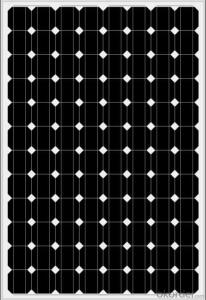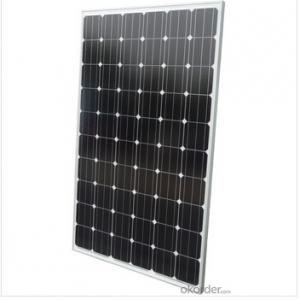Solar Module 260W Monocrystalline Solar Panels
- Loading Port:
- Shekou
- Payment Terms:
- TT or LC
- Min Order Qty:
- -
- Supply Capability:
- 30000 pc/month
OKorder Service Pledge
OKorder Financial Service
You Might Also Like
Description:
Solar modules use light energy (photons) from the sun to generate electricity through the photovoltaic effect.
The majority of modules use wafer-based crystalline silicon cells or thin-film cells based on cadmium telluride or silicon.
The structural (load carrying) member of a module can either be the top layer or the back layer.
Cells must also be protected from mechanical damage and moisture. Most solar modules are rigid, but semi-flexible ones are available,
based on thin-film cells. These early solar modules were first used in space in 1958.
CNBM Solar photovoltaic (PV) Panel is designed for large electrical power requirements.
It is the optimal choice for both on-grid and off-grid power systems.
CNBM Solar panel offers high performance of power per square foot of solar array.
Monocrystalline silicon(c-Si): often made using the Czochralski process. Single-crystal wafer cells tend to be expensive,
and because they are cut from cylindrical ingots, do not completely cover a square solar cell module without a substantial waste of refined silicon.
Hence most c-Si panels have uncovered gaps at the four corners of the cells.
Characteristics of Solar Monocrystalline
I. Solar Cell : High efficiency crystalline solar cell.
Even if under the weak light, the solar module can produce maximum power output.
II. Tempered glass (toughened glass): Anti-reflecting coating and high transmission rate glass increase
the power output and mechanical strength of solar module.
III. EVA and TPT: Using high quality EVA and TPT to prevent destroying and water.
IV. AI frame: Without screw, corner connection. 6 holes on the frame can be installed easily.
V. Junction box: Multi function junction box with water proof.
VI. Long lifetime: ≥25 years; Less power decrease.
VII. Good performance of preventing from atrocious weather such as wind and hails.
VIII. Resisting moisture and etching effectively, not effected by geology.
IX. The certificate issued by international authority: UL, TUV, IEC, VDE, CE.
Standard Test Conditions of Solar Monocrystalline
The opto-electrical specifications shown below are stabilized values being measured at Standard Test Conditions,
Irradiance: 1000W/m2, Spectrum: AM1.5 at 25°C, The info below is subject to manufacturing tolerances.
Where appropriate minutes of measurement are available and are used for the dimensioning of the installation.
Advantages of Solar Monocrystalline
• CNBM Solar performance guarantees for 25 years
• 10 years guarantee for workmanship
• Timeliness of delivery
• Quality Products certified (TÜV, UL, CE, VDE, ISO)
CNBM International Corporation's products including Monocrystalline Solar Panel,
Polycrystalline Solar Panel have received and enjoyed famous reputation in many countries and
regions in the world .As a solar panel manufacturer in China, we strive to provide our customers with excellent service,
superior products and unmatched value.

FAQ:
1. How long will my inquiry get response?
Your inquiry related to our products or prices will be replied within 24 hours.
2. Can I get professional service and suggestion?
Well-trained and experienced staffs to answer all your questions in fluent English.
3. Do you accept OEM or customized design?
OEM & ODM, any your customized lightings we can help you to design and put into product.
4. What if I need specific design?
Distributorship are offered for your unique design and some our current models.
- Q:How do solar panels perform in cloudy weather?
- Solar panels do generate electricity even in cloudy weather, although their efficiency is reduced compared to sunny days.
- Q:For example, If I were powering my house with solar panels, would it be more efficient or effective, (or I guess would I get more energy) out of a day that measured 90 degrees Fahrenheit as opposed to a day that is 70 degrees Fahrenheit.
- Not at all. You`ll generate more energy on a clear sunny day in the winter time than you would on a cloudy day in the summer.
- Q:I want to know how you can store energy using a solar panel. The energy stored needs to be stored so that a light or laptop charger can plug in to it.
- Batteries my man... but you will need a charge controller the silicon panel will produce dc and you will need an inverter for an ac light
- Q:I'm looking at solar panels and I have NO IDEA what this stuff means.They come in catagories of Watts. What does that refer to? If a solar pannel is in the 200-watt catagory, what does that really mean? Will it produce 200 watts an hour, a day, a week, a month, a year?? How many watts of energy does the average house use up in one month? I really wish they would just tell me on the website!! :(0 points!!!!!!!! :D
- This is not a precise analogy, but think of it this way: Volts is the pressure of the water in a pipe. Amps is the gallons per minute that come out. Watts is how much water you have after a certain length of time the pipe is open. a 200 watt solar panel under ideal conditions ( bright daylight between , say 0 am and 2 pm, held exactly flat to the sun ) will produce enough energy to run 2 00 watt light bulbs. You hardly ever have perfect bright sunlight; the length of the day varies during the year, and the angle of the panel to the sun changes from hour to hour; all this leads to a typical home in the US /Europe having only about 4 hours a day of maximum solar available. So, your 200 watt panel would give you 800 watts a day, enough to run one 00 watt light bulb for 8 hours If you are trying to run a house off solar, there are unfortunately other things needed between the panels and the lights / appliances; inverters, batteries, controllers sand each one eats up a little energy so you may get only 75 useful watts. See why more homes don't have panels? The other poster who said $30-50,000 to completely run a home on panels is about right.
- Q:I'm thinking of doing solar panel but i don't know how much they are i need help! please!
- no one has answered because you asked a question that cannot be answered. It is exactly the same question as how much is a car?. Do you want a passive solar heating panel, a solar electric panel, .5 Volts, ,000,000 BTUs, do you want just the panel or the panel installed and functioning, or what? the answer is between $5 and $5,000,000.
- Q:What is the difference between on-grid and off-grid solar systems?
- The main difference between on-grid and off-grid solar systems lies in their connection to the traditional electrical grid. On-grid solar systems are connected to the grid, allowing them to both generate and consume electricity from the grid when needed. They can also feed excess electricity back into the grid, earning credits or compensation through net metering. In contrast, off-grid solar systems are not connected to the grid and operate independently, relying solely on solar energy to generate and store electricity in batteries for use when the sun is not shining. Off-grid systems are typically used in remote areas where grid connection is not available or for those seeking complete energy independence.
- Q:Since plants have been populating this earth for the past 475 million years I think they have evolved to gain the most sun with their greenery. If scientists used heat sensors to find the hot spots of trees and trim all of the leaves that don't quot;providefor the plant, then maybe that trimmed tree could be used to become a solar quot;panelquot;. I believe that each individual leaf could be replaced by a small solar panel and the wood of the tree would be wiring that would root all of the solar panels to a generator.
- solar panels do not use generators, but i like your idea, very creative.though i don't see the practicality of this being used commercially, i think it would make a great solar promotional piece though! off-subject, it is time we stop looking at the upfront costs of things and start looking at what the long term costs are. most green-technology, although expensive at first, end up saving tons of resources and actually increase profits of businesses! studies show that people who work in a green building tend to be happier which benefits health, more excited to go to work due to the business's environmental ethics, are more productive because of natural lighting, and are more efficient because more work is getting done. green buildings can actually boost the efficiency of a business! thus saving tons of money and reducing tons of waste. Doesn't this just make sense to you?
- Q:My electric bill per month averages 800 kWh per month. I am looking at 65W solar panels. How many panels would I need to make my bill come to zero? I realize I also need an inverter to convert dc to ac.
- Your local installer will estimate this much more precisely than I can. Your main problem, as I see it, is not that you need this many solar panels. Your main problem is that you consume WAY too much electricity. You should probably cut your energy consumption in half BEFORE you invest in solar because it will be way more economic to eliminate the main consumers than to generate that wasted energy. I, for example, need no more than 80kWh/month for a household of two.
- Q:Can solar panels be used in multi-story buildings?
- Yes, solar panels can be used in multi-story buildings. They can be installed on the rooftops or facades of these buildings to harness solar energy and generate electricity. Additionally, advancements in solar panel technology have made it possible to integrate them into building materials, such as windows or cladding, allowing for even more flexibility in their use in multi-story structures.
- Q:Can solar panels be installed on schools or universities?
- Yes, solar panels can be installed on schools or universities. In fact, many educational institutions around the world are increasingly adopting solar energy systems to reduce their carbon footprint, lower energy costs, and provide hands-on learning opportunities for students about renewable energy. Installing solar panels on schools and universities can not only help them become more sustainable but also serve as a powerful educational tool for students and the broader community.
1. Manufacturer Overview |
|
|---|---|
| Location | |
| Year Established | |
| Annual Output Value | |
| Main Markets | |
| Company Certifications | |
2. Manufacturer Certificates |
|
|---|---|
| a) Certification Name | |
| Range | |
| Reference | |
| Validity Period | |
3. Manufacturer Capability |
|
|---|---|
| a)Trade Capacity | |
| Nearest Port | |
| Export Percentage | |
| No.of Employees in Trade Department | |
| Language Spoken: | |
| b)Factory Information | |
| Factory Size: | |
| No. of Production Lines | |
| Contract Manufacturing | |
| Product Price Range | |
Send your message to us
Solar Module 260W Monocrystalline Solar Panels
- Loading Port:
- Shekou
- Payment Terms:
- TT or LC
- Min Order Qty:
- -
- Supply Capability:
- 30000 pc/month
OKorder Service Pledge
OKorder Financial Service
Similar products
New products
Hot products
Related keywords































